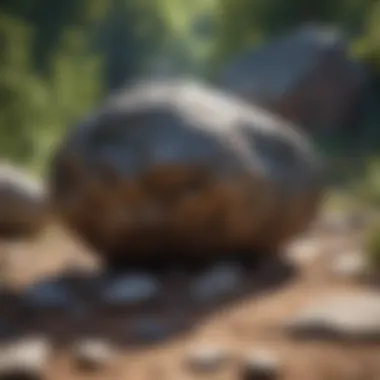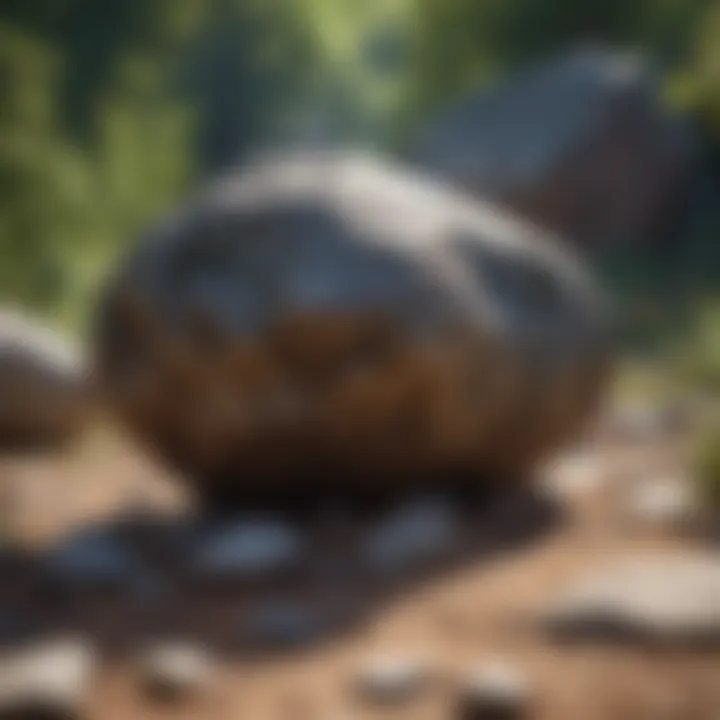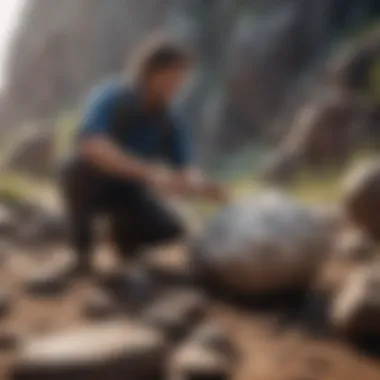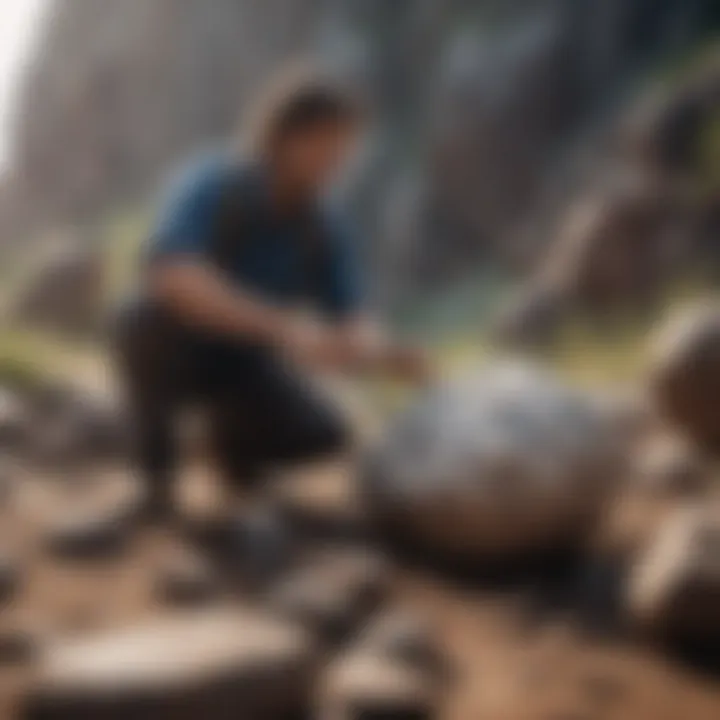Understanding Free Boulders: Geological Insights


Intro
Understanding free boulders is like peeling back the layers of Earth's geological story. These substantial rock formations aren't just random rubble; they hold tales of ancient environments, transitions in the earth's crust, and the forces of nature that shaped them. Collectors and enthusiasts alike find them fascinating for numerous reasons. From their formation processes to their impact on ecosystems, there's much to explore.
Not all boulders are created equal. Each one has its unique characteristics, appearance, and story. This article aims to unravel the complexities behind these geological giants while also offering insights for those interested in collecting them responsibly. In the upcoming sections, we will delve into their significance in natural history, explore effective identification techniques, and discuss ethical considerations for collectors.
Whether you're a seasoned collector or just dipping your toes into the world of free boulders, prepare to gain a nuanced understanding of these mesmerizing natural artifacts.
Featured Collectible of the Month
Overview
Free boulders can vary widely, but one specimen caught the eye this month: the Rainbow Boulder, found in various regions across the United States. Its vibrant hues stem from mineral inclusions that reflect light in unexpected ways, creating an almost mesmerizing appearance. Collectors praise this boulder not just for its aesthetic qualities, but also for its geological history, which can be traced back millions of years.
Historical Significance
Rainbow Boulders are not just a pretty face. They serve as geological witnesses to past events, including volcanic eruptions and tectonic shifts that occurred eons ago. Their uniqueness can be linked to specific locales, often providing insights into the conditions that prevailed during their formation. Many collectors view these boulders as conversation starters, bringing a slice of natural history into their homes while prompting intriguing discussions about the Earth’s processes.
Identification Techniques
Identifying free boulders involves more than just a glance. Here are some essential techniques to distinguish different boulder types:
Visual Characteristics
- Color Varieties: Different minerals give boulders distinct colors. For example, a reddish hue often indicates iron oxide presence, while shades of green may suggest the presence of chlorite.
- Surface Texture: Some boulders exhibit smooth surfaces due to erosion, while others may show jagged edges that highlight their rugged history.
- Size and Shape: Boulders can be round, angular, or irregularly shaped, depending on how they were formed and the environment around them.
Resources for Identification
To aid in your search for identifying free boulders, consider checking out resources like Wikipedia, or posting queries on Reddit to get insights from a community of enthusiasts.
Remember, patience and careful observation are key in your journey of appreciating these geological wonders. With the right techniques and resources, you can foster a smart collecting practice grounded in respect for nature and its history.
Prelude to Free Boulders
Delving into the world of free boulders opens up avenues of understanding not just for geology enthusiasts, but for anyone curious about the natural world. These massive rock formations, often scattered across landscapes, tell stories that can span millions of years, offering insights into Earth’s geological processes, climate changes, and even ancient ecological dynamics. The significance of studying free boulders goes beyond mere aesthetics; it is about deciphering the narratives etched in stone.
Definition and Characteristics
Free boulders are large rock fragments that have not been consolidated into bedrock but lie on the surface of the earth. They can range in size from mere pebbles to gigantic masses weighing tons. A striking feature of these boulders is their diverse composition, originating from various geological processes. For example, some may be granite, others limestone or basalt, each type presenting unique visual and structural qualities. Not only do their forms vary—some are smooth and rounded while others exhibit jagged edges—but they can showcase a rich tapestry of colors, patterns, and textures that can ignite the imagination. It is interesting to note that while most people identify boulders by their size, their physical properties, geological history, and environments where they are found play crucial roles in their classification.
Classification of Boulders
Understanding the classification of boulders uncovers a deeper comprehension of their origins and significance. Boulders can generally be categorized based on their mineral composition and the processes that formed them:
- Igneous Boulders: Created from cooled magma, these boulders can be recognized by their crystalline structure and vary in color from dark (like basalt) to light (such as granite).
- Sedimentary Boulders: Often layered and softer, these are formed from the accumulation of materials such as sand, mud, or organic remnants. They bear the imprints of their histories, often including fossils.
- Metamorphic Boulders: Resulting from extreme heat and pressure, these boulders display unique characteristics known as foliation or banding, often demonstrating striking patterns.
For collectors, understanding these classifications can significantly inform their gathering strategies, allowing them to seek specific boulders to enrich their collections. The nuances associated with each category not only deepen appreciation but aid in contextualizing the larger geological picture.
Geological Processes Behind Boulder Formation
Understanding the geological processes that contribute to boulder formation is fundamental for both collectors and enthusiasts alike. These processes offer insights into how these majestic natural structures come to be, as well as their varying characteristics and distributions. By exploring these facets, collectors can not only appreciate the beauty of boulders but can also make informed decisions when it comes to collection and conservation.
Erosion and Weathering
Erosion and weathering are two of the key natural forces that shape the world around us, breaking down larger rocks into smaller fragments and eventually into boulders. Erosion refers to the process by which soil and rock are removed from one location and transported to another, while weathering involves the breakdown of rocks through physical, chemical, and biological means. This duo can slowly but surely transform formidable cliffs into scattered boulders over millennia.
For instance, consider a weathered granite outcrop: as rainwater seeps into the cracks, it reacts chemically with the mineral components, causing the rock to weaken, spalling off large fragments. These fragments can further be worn down by wind and water as they tumble down into valleys, leading to the formation of smaller boulders that dot the landscape.
- Physical weathering processes can include:
- Chemical weathering can alter minerals within rocks due to different forces, including:
- Frost wedging, where water freezes and expands in the cracks of rocks, widening them over time.
- Thermal cycling, where temperature variations cause rocks to expand and contract, leading to fractures.
- Hydrolysis, where water reacts with minerals to form new compounds.
- Oxidation, where oxygen interacts with minerals like iron to create rust.
These processes reveal how boulders are interconnected with their environment. Consequently, a collector should understand that the boulders they encounter are stories frozen in time, reflecting the history of erosion where they were found.


Volcanic Activity and Boulder Formation
Volcanic activity stands as a formidable process in the creation of boulders, differing substantially from the slow patient work of erosion. When a volcano erupts, it spews forth magma that can solidify into large lava flows. When this lava cools, it can fracture, breaking into massive chunks of basaltic or andesitic rock that ultimately transform into boulders. Some notable sites where volcanic activity leads to the creation of boulders include the stunning landscapes of the Hawaiian Islands and the rugged terrain of Mount St. Helens.
The size of these boulders can vary significantly, with some being the size of a small car, depending on the eruption's intensity and the type of lava involved. Collecting these boulders may not just mean acquiring a unique piece of geological history but also connecting with the dynamic forces of our planet.
- Volcanic boulders can be classified based on:
- Composition (e.g., pumice, basalt).
- Texture (e.g., glassy, vesicular).
This makes each volcanic boulder a treasure of unique characteristics, often containing air pockets and minerals that tell tales of their fiery origins. Understanding these properties can help collectors appreciate their value beyond aesthetics.
Glacial Influence on Boulder Distribution
When we consider glaciers, we're looking at one of nature's most powerful sculptors. Glacial activity has a remarkable influence on boulder distribution, especially in regions that were once covered by ice. As glaciers advance and retreat, they transport immense amounts of sediment, including boulders, from one location to another, often leaving them scattered across vast landscapes.
An example of this can be seen in the northeastern United States, where the last Ice Age left behind a myriad of glacial erratics—boulders that differ from the surrounding bedrock. These boulders have been dumped by retreating glaciers and now serve as markers of our planet's climatic history.
- Key points related to glacial boulders include:
- They often show scratches or striations from being dragged beneath the ice.
- Their size and composition can give clues about their origins (e.g., origin from a different geological formation).
For collectors, understanding glacial processes can greatly enhance the appreciation of these boulders. They are not merely stones; they are remnants of past environmental conditions, offering a glimpse into Earth's history.
Ultimately, the geological processes behind boulder formation provide a backdrop that enhances the significance of these unique features in nature and culture. As one immerses themselves in the nuances of erosion, volcanic activity, and glacial influence, the complexities and interconnections of our planet become vividly clear.
Boulders in Ecosystems
Boulders play an essential role in shaping ecosystems. Often overlooked, these rock formations contribute to habitat diversity, influencing both flora and fauna in ways that may not be immediately apparent. They serve not just as mere spots in the landscape, but as keystones within their ecological communities.
Habitat Creation
Free boulders serve as critical habitat for various species, especially in environments where other forms of shelter might be scarce. The crevices and undercuts of boulders can provide shelter for small mammals, reptiles, and a wealth of insects. In many regions, such as rocky outcrops in temperate forests or arid desert landscapes, you can find that these boulders act as miniature ecosystems. They offer a modicum of moisture and shade that supports unique plant species that wouldn’t thrive in direct sunlight.
Consider, for instance, the diverse world beneath a single large boulder. Mosses, lichens, and other small plants might thrive off of moisture that collects in its crevices during rain. When examined closely, one can find an entire community of life: spiders weaving their webs, insects crawling over the surface, and amphibians finding refuge from broiling heat.
Boulders also play a role in the alteration of local microclimates. Their physical presence can block wind, create shade, or retain moisture. This not only aids in sustaining the aforementioned species but also contributes to the emergence of new breeding grounds for birds that prefer nesting in elevated, rocky areas.
"A single boulder can host an entire world, hidden from our eyes yet teeming with vitality."
Biodiversity and Boulders
The significance of boulders extends further into biodiversity. By providing niches—specific spaces where organisms can exist—boulders foster a rich tapestry of life. Species that thrive in these microhabitats often differ from those in surrounding areas, leading to increased biodiversity.
- Niche Diversification: The uneven surfaces and varying heights of boulders allow for different species to occupy varied niches. Sun-loving plants can flourish at the top, while shade-tolerant species may find a home at the base.
- Wildlife Corridors: In many ecosystems, boulders help create pathways for wildlife. They serve as stepping stones, facilitating animal movement between habitats and ensuring genetic diversity through interaction.
- Pollinators: These large stones can draw in pollinators such as bees and butterflies, which often find refuge in the flowers that grow around them, unknowingly ensuring the reproduction of plants across vast areas.
In summary, the humble boulder offers irreplaceable contributions to ecological health, supporting life in ways that are both intricate and essential. The interconnectivity between boulders and ecosystem functions illustrates just how fundamentally important these couriers of geology are to our planet.
Cultural Significance of Boulders
Boulders are not just geological marvels; they have long been woven into the fabric of human history and culture. Their immense size and presence often evoke a sense of awe and inspire various cultural beliefs and practices. Free boulders serve as natural canvases for expression, community spaces, and even historical references. Understanding the cultural significance of boulders deepens our appreciation for their role beyond mere geological formations.
Historical Uses of Boulders
Boulders have been utilized by civilizations throughout history, symbolizing strength and permanence. Many ancient societies viewed these natural structures as sacred. In some regions, tribes carved images or symbols onto them, creating a canvas for spiritual expression. For instance, ancient Native American tribes often left their mark on stones, using them in ceremonies or as markers for territory and resources. These practices not only reveal their reverence for nature but also indicate the way in which they interacted with their environment.
Historically, boulders were also used pragmatically. Think of early humans who relied on large stones for practical tools or even construction. In places like Stonehenge, massive stones were not just art; they were integral to monumental architecture that has stood the test of time. Their presence speaks volumes about human ingenuity and the lengths to which people went to harness the natural world.
"Boulders, like storytellers, hold within them the whispers of the past—each striation, each groove a testimony of time's passage."
Boulders in Art and Literature
From the pages of literature to the strokes of an artist's brush, boulders have inspired countless works of art and literature. In literature, they often symbolize stability, endurance, and the weight of the past. The romantic poets of the 19th century, for instance, frequently used natural imagery, including boulders, to evoke emotions tied to nature’s grandeur and humanity’s place within it. One could find numerous references to stones representing obstacles or the immovable nature of life’s challenges.
Artists, too, have drawn inspiration from the raw beauty of boulders. Sculptors like Henry Moore experimented with stone, pushing the boundaries of form and abstraction. His organic forms echo the natural world, highlighting the gentleness surrounding such stark materials. Boulders and rocks have become subjects of paintings, symbolizing natural landscapes and serving as metaphors for emotional landscapes as well.
In various cultures, boulders are also prevalent in myths and folklore, often representing something eternal. From tales of ancient gods to local legends, they are essential components that reflect the values, fears, and aspirations of a community. The artistic interpretations of boulders serve a dual purpose: they encapsulate cultural identity and provoke thought about mankind's relationship with nature.


Understanding these cultural significances surrounding boulders invites us to see these geological giants not just as stones, but as narrators of history, art, and human connection.
Exploring Free Boulders: Collecting Perspectives
Collecting free boulders is not just a hobby for enthusiasts; it's a window into understanding geological history and the natural world. This section examines how collectors approach their passion, the tools of the trade, and some best practices. Whether you’re a novice or have been in the field for years, insights into identifying and collecting suitable free boulders are invaluable.
Identifying Suitable Boulders for Collection
Finding the right boulder to add to your collection might seem daunting, but there are a few tricks of the trade that can make this task a lot easier. First, pay attention to the surroundings of the boulders. Look for unique colors, textures, and shapes that catch your eye. Each boulder tells a story. A smooth, round boulder might have been shaped by glacial action, while one with sharp edges may have been recently broken off from a larger formation.
Consider the geological layer from which these boulders originate. Certain areas might yield boulders with fossils or intriguing mineral compositions. For instance, granite boulders can often carry crystals within their matrix. It’s also crucial to be mindful of local regulations regarding boulder collection. Some areas may prohibit collection outright, while others have specific guidelines.
"Look before you leap; knowing what you collect and where you collect it matters immensely."
Things to Consider When Identifying Suitable Boulders:
- Location: Are you at a known geological site?
- Condition: Is the boulder stable and unweathered?
- Legal Aspects: Do you have permission to collect?
- Rarity: Is this boulder unique in its characteristics?
Methods of Boulder Collection
Once you've identified a promising boulder, the next step involves collection methods. Depending on the size and weight, there are varying approaches to extracting these large stones without causing damage to them or the surrounding area. Using the right equipment, such as rock hammers, chisels, and safety gear, is essential.
For smaller pieces, hand tools might suffice, but for larger specimens, you might need some extra muscle. Lever systems or sledging techniques can help in moving substantial boulders. Always bear safety in mind; ensure that you’re wearing proper protective gear, including gloves and sturdy footwear. It’s not just about the boulder; your safety is paramount.
Steps for Boulder Collection:
- Assessment: Evaluate the boulder's size and surroundings.
- Tools Selection: Choose appropriate tools (e.g., sledgehammer, chisels).
- Extraction: Carefully remove the boulder from the bedrock.
- Transport: Use a wheelbarrow or similar equipment if needed.
By equipping yourself with knowledge about identifying and methodically collecting boulders, you can not only enhance your collection but also appreciate the geology behind these amazing natural structures. Collecting free boulders can offer a profound connection to the land and its history, making it a rewarding endeavor.
Preservation and Care of Collected Boulders
Preserving collected boulders is not simply a matter of keeping an interesting rock in your yard or collection. It plays a fundamental role in understanding their geological significance, ensuring that future enthusiasts and researchers can study them and appreciate their story. Without proper care, boulders—even ones that seem nearly indestructible—can suffer from deterioration due to environmental factors, handling, or even the effects of time.
Taking the time to clean and store your boulders correctly will enhance their longevity and maintain the integrity of their features. These structures hold valuable geological records, and by caring for them, collectors uphold their duty to conservation.
Cleaning Techniques
Proper cleaning techniques are essential to preserving the natural beauty and scientific value of your collected boulders. Collectors should avoid aggressive methods that may damage the boulder's surface. Here are some effective and gentle cleaning techniques:
- Soft Brushes: Use a soft-bristled brush to remove dirt and debris without scratching the surface.
- Water and Mild Soap: A mixture of lukewarm water and mild soap can work wonders. Just make sure to rinse thoroughly afterwards.
- Avoid High Pressure: Never use a pressure washer; the force can erode delicate features and textures.
- Prevent Chemical Damage: Stay clear of harsh chemicals that can react with mineral compositions and stain the boulder.
Another useful tip involves allowing your boulders to dry in a shaded area post-cleaning, as direct sunlight can cause cracking due to rapid temperature changes.
Storage Recommendations
Where and how you store your collected boulders can significantly affect their condition. Here’s what to consider:
- Indoor vs. Outdoor: If possible, store them indoors to shield from extreme weather, which can lead to cracks or discoloration. If outdoors, ensure that they are placed in a location with adequate drainage to avoid moisture accumulation.
- Support Structures: When stacking or displaying boulders, always make sure they are stable and supported evenly to prevent tipping or chipping.
- Limit Contact: Avoid frequent handling. If you must move a boulder, use padding to protect it from impact, and always lift with care, using both hands.
- Humidity Control: If you live in a humid area, consider using silica gel packs or a dehumidifier in your storage space to control moisture levels.
Remember, the goal of preserving your boulders is not just for personal enjoyment but for sharing their beauty and significance with future generations. They are a piece of natural history that deserves thoughtful stewardship.
Ethical Considerations in Boulder Collection
When it comes to gathering free boulders, the notion of ethics should stand as a cornerstone of one’s collecting philosophy. This aspect is essential not merely for the preservation of our natural environment but also for fostering a respectful bond between collectors and the geological wonders we cherish. Collecting boulders without a keen awareness of ethical practices not only risks the environment but can also tarnish the reputation of the entire community of collectors.
Sustainability Practices
Sustainability encompasses the idea of collecting in such a way that future generations can enjoy the same beauty and diversity of nature that we do today. As collectors, one must consider the environmental impact of removing boulders from their natural habitat. For instance, removing a boulder may disrupt ecosystems, affect plant life, and alter the natural landscape. Therefore, here are some sustainability practices to keep in mind:
- Leave No Trace: Only collect what is needed; don’t rummage through the area unnecessarily.
- Respect Local Wildlife: Avoid disturbing habitats and nesting sites. The presence of boulders often provides shelter and resources for various species.
- Utilize A Permitted Collection Process: Familiarize yourself with collection guidelines from local authorities or organizations. These guidelines ensure responsible practices are followed, preserving the natural landscape.
By adhering to sustainable practices, collectors can minimize the impact of their activities on the environment. After all, the aim is to enjoy and appreciate boulders not only in the present but also for those who come after us.
Legal Guidelines for Collection


Navigating through the legalities of collecting is paramount if one wishes to embark on this rewarding hobby responsibly. Each region has its own laws and regulations concerning the collection of natural resources, including boulders. Here are key points to keep in mind when it comes to legal guidelines for boulder collection:
- Research Local Laws: Before embarking on a collecting expedition, ensure you have the latest information about local laws. Some areas, such as national parks and certain reserves, strictly prohibit the removal of natural resources.
- Permits May Be Required: In some locations, you’ll need a permit to collect rocks and minerals. This is particularly true for sensitive ecological areas. Always apply for the required permits before you head out.
- Respect Private Property: Always obtain permission before collecting on private lands. Trespassing can have serious consequences and can jeopardize your ability to collect in the future.
Remember, being aware of legal guidelines not only protects you as a collector but also ensures that you are doing your part to uphold the integrity of the land and its laws.
By integrating ethical practices into your boulder collecting endeavors, you not only elevate your own experience but also contribute to a broader culture of respect for nature and its resources. Engaging responsibly reinforces the idea that our natural world is a shared legacy, meant to be cherished and preserved.
Notable Sites for Free Boulder Exploration
Exploring free boulders can take enthusiasts and collectors on a thrilling journey through some of nature’s most stunning landscapes. The places where these boulders reside are essential because they offer not only the potential for unique finds but also a chance to connect with the geological processes that created them. Understanding which sites are notable can make all the difference in the collection experience. From national parks teeming with protected biodiversity to local public lands rich with history, each location has its distinct flavor and opportunities.
- Learning Opportunities: Each site tells its own geological story, making it a living laboratory for geology lovers.
- Ecological Diversity: Diverse boulder formations support various species, enriching the ecosystem and offering collectors a closer look at nature's canvas.
- Cultural Insights: Many sites have historical significance, which adds layers of meaning to the boulders collected from these areas.
Visiting these sites is not just about collecting boulders; it’s about understanding their journey through time and space.
National Parks and Natural Reserves
National parks and natural reserves often stand as guardians of boulders, showcasing their impressive grandeur while preserving the ecology for future generations. Each national park brings forth its set of unique geological features, making them prime locations for collectors. For example, parks like Joshua Tree in California present striking boulders formed through volcanic activity and erosion, while formations in Glacier National Park tell tales of glacial movements.
- Protected Environment: Collecting is usually restricted or regulated; hence enthusiasts can often appreciate natural formations without the encumbrance of human interference.
- Educational Programs: Many parks offer ranger-led programs that focus on geology and ecology, turning an ordinary visit into an educational experience.
- Diverse Locations: From the rugged landscapes of Rocky Mountain National Park to the coastal cliffs of Acadia, the variety is vast.
Local Public Lands and Their Offerings
Local public lands, often overlooked, can sometimes yield unexpected treasures. These sites are not just about accessibility. They can be full of hidden gems that tell a different story than their more famous counterparts. Visiting local spots allows collectors to connect deeply with their immediate environment while enjoying a more personalized experience, unmarked by the heavy foot traffic prevalent in national parks.
- Community Engagement: Local public lands often have gatherings or events aimed at fostering a community spirit among collectors and nature enthusiasts.
- Less Regulation: Some regions have few restrictions, allowing for a more open collecting experience.
- Evolving Sites: These areas can be dynamic and change with time. A rainy season or time of year may reveal new boulders or obscure others that turn them into a seasonal treasure hunt.
In summary, both national parks and local public lands offer distinctive advantages for exploring free boulders. They serve as vital resources for collectors and provide a deeper understanding of the geological processes that shape our world. Collecting at these sites not only fosters a connection to nature but also encourages responsible stewardship—reminding us to preserve these treasures for generations to come.
Personal Experiences: Stories from Collectors
When it comes to free boulders, personal experiences of collectors can be quite illuminating. These stories reflect not only the joy of discovery but also the challenges faced along the way. Diving into these narratives allows us to appreciate the nuances of boulder collecting, from the selection of sites to the techniques used in the collection process. Understanding their journeys can shed light on the broader implications of boulder exploration, making it essential to include these perspectives in our discussion.
Challenges Faced During Collections
Boulders can often be found in rugged terrains. Collectors often recount stories filled with physically demanding conditions, such as steep slopes and unstable rocky ground. Safety concerns emerge frequently; slips and falls are not unheard of and can pose real risks in wild environments. Beyond physical dangers, the legalities associated with claiming a rock from various sites can be quite tangled. Some collectors recount times when they were told to leave by park rangers or local authorities, reminding us that being informed is paramount. Some typical challenges include:
- Understandig Local Laws: Not knowing specific local regulations can lead to complications when collecting.
- Transporting Rocks: Navigating the logistics of moving a heavy boulder can prove frustrating.
- Identifying Quality Specimens: Deciding which boulders to collect based on their geological significance can be overwhelming.
With all of these considerations, the thrill of the hunt is only matched by the careful planning that precedes it.
Unique Finds and Their Importance
Every collector has that remarkable find — a boulder that somehow stands apart from the rest. These discoveries can vary significantly, such as a rock featuring rare mineral compositions or distinctive textures. One collector shared a tale of a boulder etched with ancient petroglyphs, revealing insights into past cultures. Such finds not only enrich a collector's personal collection but also contribute to our understanding of geological time and human history.
"The moment I unburied that boulder with petroglyphs, I felt connected to something larger than myself. It was like holding a piece of ancient history in my hands," a collector once said.
These unique boulders can hold immense educational value, sometimes leading to collaborations with museums or educational institutions. Additionally, the story behind each boulder becomes part of its legacy, adding personal and communal significance.
In essence, personal experiences from collectors reveal much about free boulders and their importance beyond the mere act of collecting. They illuminate the passion, diligence, and, at times, adversity faced in pursuit of these geological treasures.
Future of Boulder Collecting
As we look ahead into the future of boulder collecting, the landscape is changing rapidly, driven by both technological advancements and evolving societal values. This section serves as a compass, guiding enthusiasts through the potential transformations and challenges that could shape their boulder-collecting adventures. The importance of understanding these trends cannot be overstated. Not only do they enhance knowledge for collectors, but they also facilitate sustainable practices, a crucial consideration as the demand for natural specimens continues to grow.
In focusing on the future, collecters can align their activities with modern methods and ethical standards. By adapting to new technologies and understanding emerging trends, collectors can maximize their efforts while minimizing negative impacts on the environment. As it stands, the future is not just about amassing a collection of rocks; it's about being responsible stewards of nature, ensuring that future generations can enjoy boulders in their natural settings as well.
Technological Advances in Methodologies
The world is witnessing a tech revolution, and boulder collecting is no exception. Today, various technological tools are reshaping how collectors identify, catalog, and acquire boulders. For instance, mobile apps equipped with GPS capabilities are allowing enthusiasts to pinpoint precise locations of rare formations. These apps are often integrated with community maps that provide insights into environmental regulations, thus fostering a sense of responsibility among users.
Additionally, 3D scanning technology is making its mark in cataloging boulders for personal collections or academic purposes. Not only does this method create digital representations of stones, but it also aids in preserving their unique features without physically removing them from their location. Moreover, virtual reality platforms can now simulate boulder exploration, offering collectors a risk-free way to experience different environments.
This is just the tip of the iceberg. The combination of technology with geology promises to facilitate education on how to responsibly source and collect boulders, perhaps leading to a new generation of well-informed enthusiasts.
Trends in Collecting Practices
An increasing awareness of sustainability is influencing collecting practices—especially among rocks and fossil collectors. Many in the community are shifting toward ensuring that their activities do not contribute to environmental degradation. This change is not merely a passing trend; it indicates a broader cultural shift that prioritizes conservation.
- Ethical Sourcing: More collectors today seek rocks that can be gathered without harming ecosystems. This could mean opting for boulders that have naturally weathered and broken down rather than larger, intact specimens that might be integral to their environment.
- Community Engagement: Many enthusiasts are organizing local clean-up events or collaborative hikes, where the aim is not just to collect, but also to preserve natural areas. This fosters a sense of camaraderie while reinforcing a sustainable ethos.
- Education and Awareness: As the knowledge surrounding geology continues to enhance, so does the sophistication of collecting practices. Workshops and online forums are increasingly providing collectors with valuable insights into the geological significance of specific formations and best practices for responsible collecting.
In summary, as we venture forth into the future, it is imperative for rock and fossil collectors to stay informed and adaptable. The journey into boulder collecting offers vast opportunities not merely for personal satisfaction but also for contributing positively to our planet.



